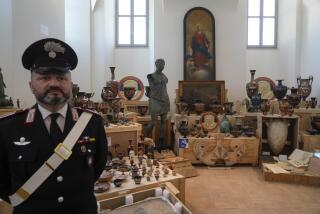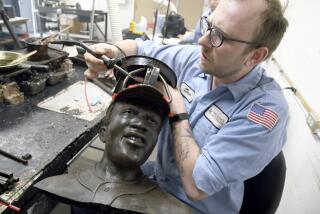Italian official seeks return of âGetty Bronzeâ
An Italian government official came to Los Angeles last week to propose a settlement to the long-running dispute with the J. Paul Getty Museum over one of its most important ancient masterpieces, a bronze statue of a victorious athlete known as the âGetty Bronze.â
Gian Mario Spacca, president of the Italian region of Marche where the statue was hauled ashore by fishermen in 1964, met with Getty officials Friday to discuss a deal in which the statue would be shared as part of a broader exchange of art.
The talks come as an Italian court is expected to issue a verdict on the Gettyâs appeal of a February 2010 ruling that the statue was illegally removed from the country four decades ago and should be returned.
If the February ruling is upheld, it is not clear if an Italian request that the statue be seized would be enforced in the United States.
âWe are not here to declare war on the Getty,â Spacca said in a statement to The Times. âWe are here to resolve the dispute in a way that will benefit the museum, the people of Italy, and most important, art lovers around the world.â
Getty spokesman Ron Hartwig described the meeting as âa good discussionâ but said serious talks would be possible only after the court case ends and would need to involve the Italian Ministry of Culture.
âWe were clear at the start of our conversation that the statue of a âVictorious Youth,â known as the âGetty Bronze,â was not a matter for discussion since legal issues regarding this object are ongoing in Italy.â
In recent years, the Getty and other American museums have acknowledged a history of unethical acquisition practices and sought to resolve similar disputes through negotiations. Just last week, the Getty returned to Italy its prized statue of Aphrodite, one of 40 illicitly excavated objects returned since 2007 as part of an agreement that has brought the Getty several loans of priceless Italian art.
But given the bronzeâs importance and its murkier ethical situation â it was found in international waters, not illegally excavated from Italian soil â museum officials have signaled they are willing to fight for the piece.
The statue was found by Italian fishermen off Italyâs Adriatic coast in 1964. They hauled it ashore in the small port town of Fano, buried it in a cabbage field and then hid it in a priestâs bathtub rather than declare it to customs officials, as required under Italian law. Three brothers and the priest were convicted of trafficking in stolen goods, but an appeals court threw out their convictions in 1970, citing insufficient evidence. At the time, the statue was still missing and its value was unknown.
In the early 1970s, the statue resurfaced in London, where millionaire oilman J. Paul Getty first became enamored of it. Experts believe the statue may be the lone surviving work of Lysippus, the master Greek artist who served as the personal sculptor for Alexander the Great. It was most likely lost at sea after being plundered by Roman soldiers around the time of Christ. (The government of Greece has never asked that the statue be returned there.)
Getty himself never authorized the purchase of the statue because he had concerns about its legal status, records show. In 1974, Italian officials tried to seize the statue in Germany, where it was being restored, but authorities there would not honor the request.
It was only after Gettyâs death in 1976 that his namesake museum purchased the statue, ignoring the legal conditions its founder had placed on the acquisition, according to documents related to the case. The statue was one of the museumâs first acquisitions and was dubbed the âGetty Bronze.â
The bronze was one of dozens of ancient objects demanded by Italy during a lengthy fight with the Getty in recent years over its antiquities collection, much of which was acquired from middlemen who trafficked in objects recently looted from Italian tombs and ruins.
Talks broke down when the Getty refused to include the bronze on a list of objects it was willing to return. The impasse was broken only when a new criminal case about the bronze was filed in Italian court in 2007, removing it from the negotiating table.
That case has wound through the Italian legal system ever since, with the Getty appealing the courtâs February 2010 ruling to Italyâs highest court, which refused to hear the case. It is now back before a judge in Pesaro, not far from the port where the statue was first hauled ashore.
Like other objects in the dispute, the bronze statue has become a symbol for the people of the region â of Italyâs ancient heritage (though the object is Greek) and of a potential draw for tourism.
âIt is of great interest to have the statue returned to Fano, from where it disappeared years ago,â Spacca said. âI trust that a museum as prestigious as the Getty will show the world that it is a cultural institution that behaves ethically.â
More to Read
The biggest entertainment stories
Get our big stories about Hollywood, film, television, music, arts, culture and more right in your inbox as soon as they publish.
You may occasionally receive promotional content from the Los Angeles Times.










